By Leen Randell
Updated: Jul 04, 2024
10 Best Herbal Decoctions For Peptic Ulcers
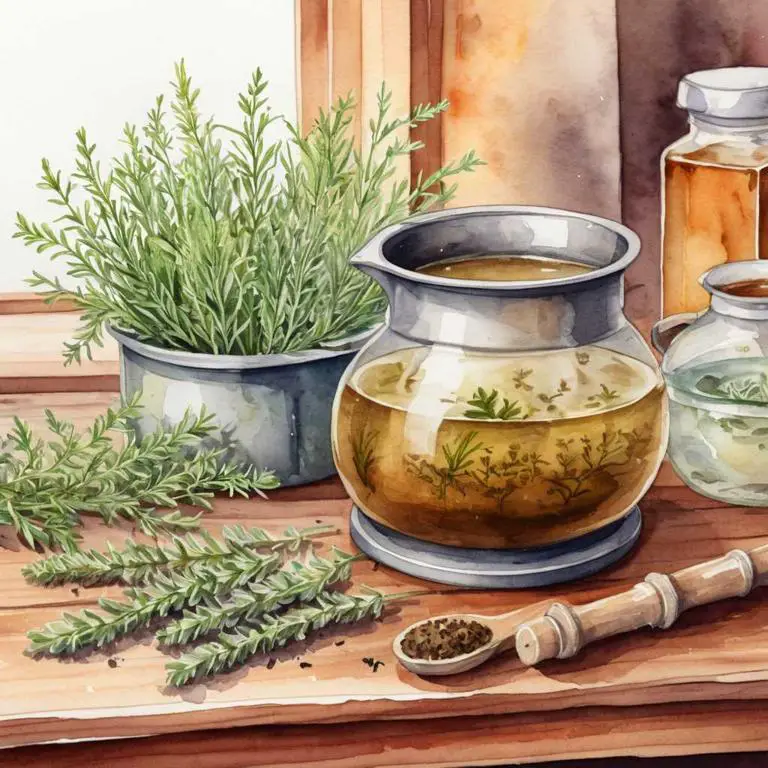
Herbal decoctions for peptic ulcers are liquid extracts made by steeping herbs in hot water, used to alleviate symptoms and promote healing of peptic ulcers.
These decoctions work by reducing inflammation, improving digestion, and increasing mucous production in the stomach lining, thus protecting against acid erosion. Examples include chamomile, licorice root, and marshmallow root decoctions, which have anti-inflammatory and soothing properties that help to reduce pain and discomfort associated with peptic ulcers.
By using these herbal decoctions, individuals can find relief from symptoms, improve their quality of life, and enjoy a better overall health.
The following article describes in detail the most important decoctions for peptic ulcers, including medicinal properties, parts of herbs to use, and recipes for preparations.
- 1. Glycyrrhiza glabra
- 2. Althaea officinalis
- 3. Zingiber officinale
- 4. Curcuma longa
- 5. Camellia sinensis
- 6. Mentha x piperita
- 7. Matricaria chamomilla
- 8. Triticum aestivum
- 9. Taraxacum officinale
- 10. Urtica dioica
- What is the best combination of herbal decoctions to use for peptic ulcers?
- What ailments similar to peptic ulcers are treated with herbal decoctions?
1. Glycyrrhiza glabra
Licorice decoctions helps with peptic ulcers because of its anti-inflammatory properties, which reduce inflammation in the stomach lining and protect it from further damage.
The decoction's glycyrrhizin content also inhibits the production of gastric acid, which can help alleviate symptoms such as heartburn and abdominal pain.
Additionally, licorice root has been shown to promote healing by stimulating the growth of new tissue in the stomach lining, effectively repairing damaged areas and promoting a healthy digestive tract.

Medicinal Constituents
The list below shows the primary medicinal constituents in Glycyrrhiza glabra decoctions that help with peptic ulcers.
- Licorinic acid: This triterpenoid saponin has anti-inflammatory properties, which help in reducing inflammation and preventing further damage to the mucous membranes in peptic ulcers.
- Glycyrrhizin: This triterpenoid saponin has cytoprotective properties, which help in protecting the mucous membranes from acid and enzyme damage, facilitating faster healing of peptic ulcers.
- Isoflavans: These phenolic compounds have antioxidant properties, which help in neutralizing free radicals and reducing oxidative stress, thereby promoting healing and preventing further damage to the mucous membranes in peptic ulcers.
Parts Used
The list below shows the primary parts of licorice used to make decoctions for peptic ulcers.
- Roots: The roots are the primary part used due to their high concentration of glycyrrhizin, a compound that helps to reduce inflammation and protect the stomach lining.
- Leaves: The leaves are used to some extent, as they contain smaller amounts of glycyrrhizin, but still contribute to the overall anti-inflammatory effects.
- Barks: The barks are occasionally used, although they contain less glycyrrhizin than the roots, still providing some benefits for soothing the stomach and reducing inflammation.
Quick Recipe
The following recipe gives a procedure to make a basic licorice for peptic ulcers.
- Gather 3-5 grams of dried roots and wash them under cold running water to remove any impurities.
- Cut the roots into smaller pieces and soak them in a vessel for 2-3 hours to rehydrate.
- Boil 1 liter of water and then add the rehydrated root pieces to the boiling water.
- Reduce the heat to a simmer and let the mixture cook for 10-15 minutes or until it reduces to half.
- Strain the decoction through a cheesecloth or a fine-mesh sieve into a container to remove the solids.
2. Althaea officinalis
Marshmallow decoctions helps with peptic ulcers because of its mucilaginous properties, which soothe and protect the digestive tract.
The gel-like substance coats and shields the stomach lining from irritants, reducing inflammation and discomfort caused by peptic ulcers. Additionally, marshmallow root contains anti-inflammatory compounds that help to neutralize acid production, further alleviating symptoms.
By providing a protective barrier and reducing inflammation, marshmallow decoctions can provide relief for individuals suffering from peptic ulcers, promoting healing and comfort in the digestive system.
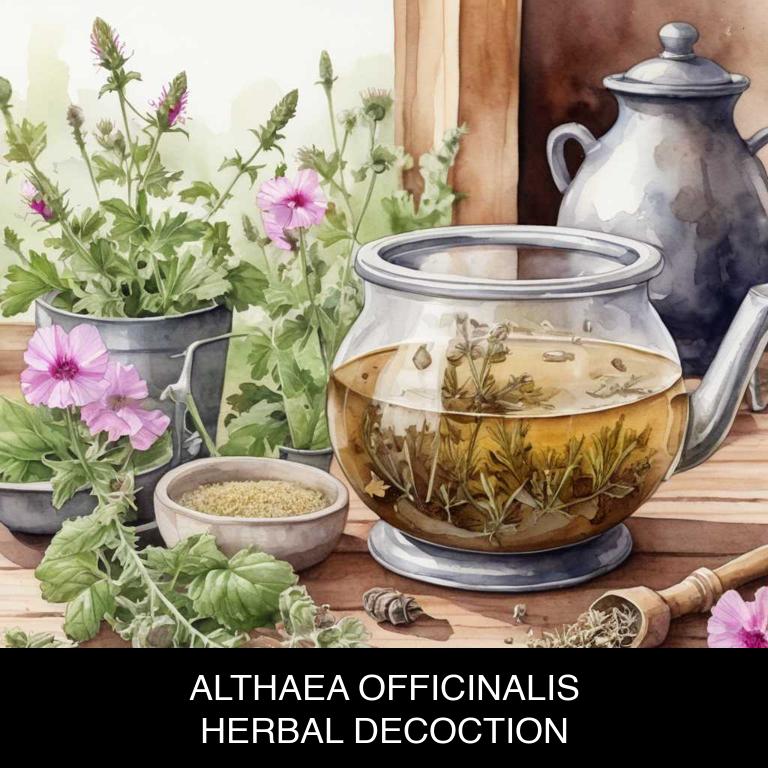
Medicinal Constituents
The list below shows the primary medicinal constituents in Althaea officinalis decoctions that help with peptic ulcers.
- Mucilages: These complex carbohydrate compounds help protect and soothe the gastrointestinal lining, reducing inflammation and promoting healing of peptic ulcers.
- Polysaccharides: These polysaccharide molecules have been shown to possess anti-inflammatory and antioxidant properties, which help reduce oxidative stress and alleviate symptoms associated with peptic ulcers.
- Glucosides: These flavonoid glucosides have been found to possess protective effects against gastric mucosal damage, likely due to their antioxidant and anti-inflammatory properties, which help maintain the integrity of the gastric mucosa and prevent further peptic ulcer development.
Parts Used
The list below shows the primary parts of marshmallow used to make decoctions for peptic ulcers.
- Roots: These are the primary part used due to their high mucilage content, which helps soothe and protect the digestive tract.
- Leaves: Leaves are also used in decoctions for peptic ulcers, as they contain similar mucilage properties to the roots.
- Stems: Some traditional remedies use stems of Althaea officinalis for their mucilage content, which aids in soothing and healing ulcers.
Quick Recipe
The following recipe gives a procedure to make a basic marshmallow for peptic ulcers.
- Gather 1 to 2 teaspoons of dried althaea officinalis root, depending on your desired decoction strength.
- Combine the gathered root with 1 cup of boiling water in a heat-resistant glass or ceramic container.
- Reduce the heat to a simmer and let the mixture steep for 5 to 10 minutes.
- Strain the decoction using a cheesecloth or a fine-mesh sieve into a separate container.
- Allow the decoction to cool before consuming or storing it in the refrigerator for up to 24 hours.
3. Zingiber officinale
Ginger decoctions helps with peptic ulcers because of its anti-inflammatory properties, which help to reduce inflammation in the stomach lining and alleviate symptoms such as heartburn, bloating, and abdominal pain.
The decoction's high concentration of gingerols and shogaols also stimulates digestion, reducing acidity and improving nutrient absorption, which can aid in healing and protecting the stomach lining from further damage.
This natural remedy has been traditionally used to soothe digestive issues and promote overall gut health.
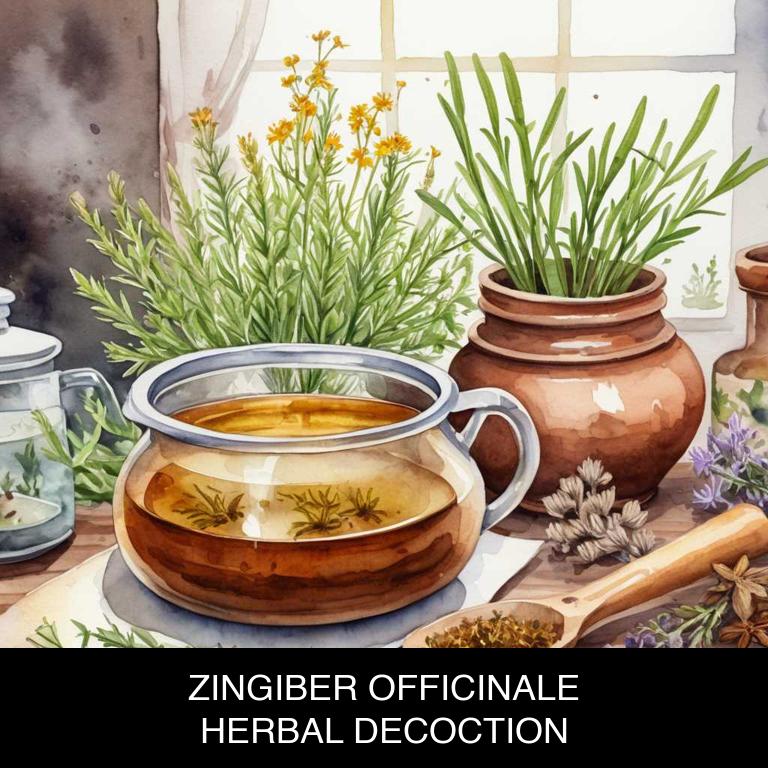
Medicinal Constituents
The list below shows the primary medicinal constituents in Zingiber officinale decoctions that help with peptic ulcers.
- Gingerols: These sesquiterpene compounds have anti-inflammatory and antioxidant properties, which help reduce inflammation and promote healing in peptic ulcers.
- Shogaols: Similar to gingerols, shogaols have anti-inflammatory and antioxidant properties, which help protect the gastric mucosa and reduce the risk of peptic ulcer formation and recurrence.
- 6-gingerol: This gingerol is particularly effective in reducing gastric acid secretion and promoting the production of mucus in the stomach, which helps protect the gastric mucosa and alleviate symptoms of peptic ulcers.
Parts Used
The list below shows the primary parts of ginger used to make decoctions for peptic ulcers.
- Rhyzomes: The rhyzomes of Zingiber officinale are used because they contain compounds like gingerol and shogaol, which have anti-inflammatory properties that help soothe and protect the stomach lining.
- Roots: The roots of Zingiber officinale are used because they contain a high concentration of bioactive compounds that help reduce inflammation and promote digestion.
- Barks: The barks of Zingiber officinale are used because they contain compounds that help reduce nausea and alleviate symptoms of peptic ulcers.
Quick Recipe
The following recipe gives a procedure to make a basic ginger for peptic ulcers.
- Harvest the fresh zingiber officinale rhizomes at dawn when they are most potent and less fibrous.
- Clean and peel the zingiber officinale rhizomes and then chop them into small pieces weighing about 200 grams.
- Combine the chopped rhizomes with 2 liters of distilled water in a saucepan and bring to a boil.
- Reduce the heat to a simmer and let it steep for 20-30 minutes to allow the active compounds to infuse.
- Strain the decoction through a cheesecloth or a fine-mesh sieve and discard the solids to obtain the final product.
4. Curcuma longa
Turmeric decoctions helps with peptic ulcers because of its potent anti-inflammatory properties, which reduce inflammation in the digestive tract and alleviate symptoms.
Curcumin, a key compound in turmeric, has been shown to inhibit the growth of Helicobacter pylori bacteria, a common cause of peptic ulcers.
Additionally, curcumin's antioxidant properties help protect the stomach lining from damage caused by acid reflux and gastritis, promoting healing and reducing the risk of complications.
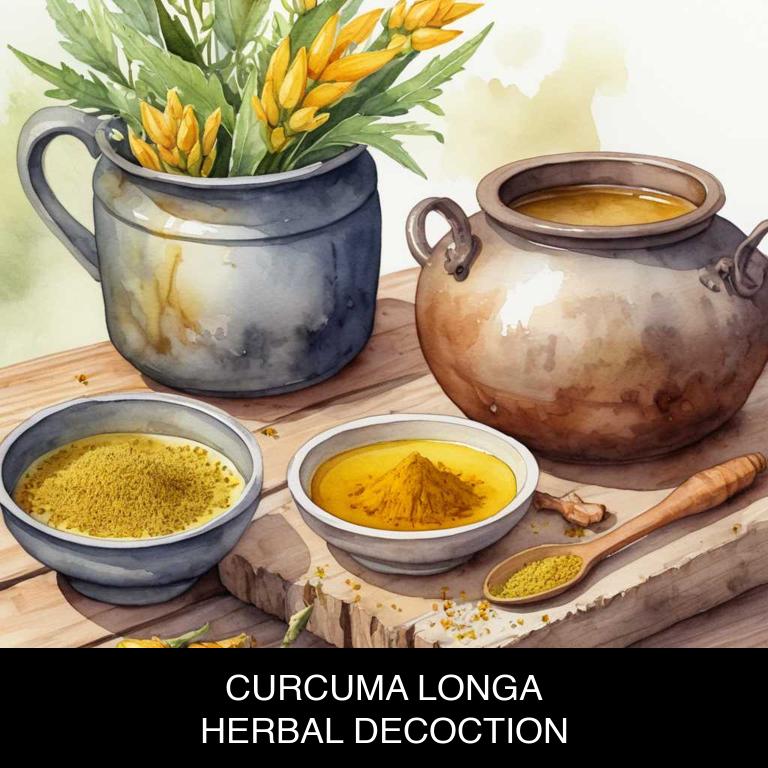
Medicinal Constituents
The list below shows the primary medicinal constituents in Curcuma longa decoctions that help with peptic ulcers.
- Curcumin: Helps with peptic ulcers by inhibiting the production of inflammatory mediators, such as prostaglandins and leukotrienes, which contribute to ulcer formation and exacerbation.
- Demethoxycurcumin: Contributes to the anti-ulcerogenic effect by suppressing the growth of Helicobacter pylori, a bacterium responsible for many peptic ulcers, and also reducing the production of pro-inflammatory cytokines.
- Bisdemethoxycurcumin: Exhibits anti-ulcerogenic activity by inhibiting the production of pro-inflammatory enzymes, such as cyclooxygenase-2 (COX-2), which is involved in the formation and maintenance of peptic ulcers.
Parts Used
The list below shows the primary parts of turmeric used to make decoctions for peptic ulcers.
- Rhyzomes: They are used due to their high content of curcumin, a compound with potent anti-inflammatory and antioxidant properties that helps in healing and protecting the stomach lining.
- Roots: The roots contain compounds that have anti-inflammatory and antiseptic properties, which aid in reducing inflammation and preventing infections associated with peptic ulcers.
- Stems: The stems of Curcuma longa contain compounds with antioxidant properties, which help in protecting the stomach lining from damage and promoting healing in cases of peptic ulcers.
Quick Recipe
The following recipe gives a procedure to make a basic turmeric for peptic ulcers.
- Harvest curcuma longa rhizomes in the early morning after the dew has dried to ensure freshness.
- Peel the rhizomes and cut them into small pieces to release their active compounds.
- Combine 1-2 teaspoons of the cut rhizomes with 4 cups of water in a saucepan.
- Bring the mixture to a boil then reduce the heat and simmer for 10-15 minutes.
- Strain the decoction and discard the solids to obtain a clear herbal liquid.
5. Camellia sinensis
Tea decoctions helps with peptic ulcers because they contain a blend of bioactive compounds that soothe and protect the mucous membranes in the digestive tract.
These compounds, found in herbs such as licorice root, chamomile, and slippery elm, work to reduce inflammation and promote healing by coating the stomach lining and preventing further damage.
Additionally, herbal tea decoctions can help regulate digestion and improve gut health, which is essential for managing peptic ulcers and promoting overall well-being.
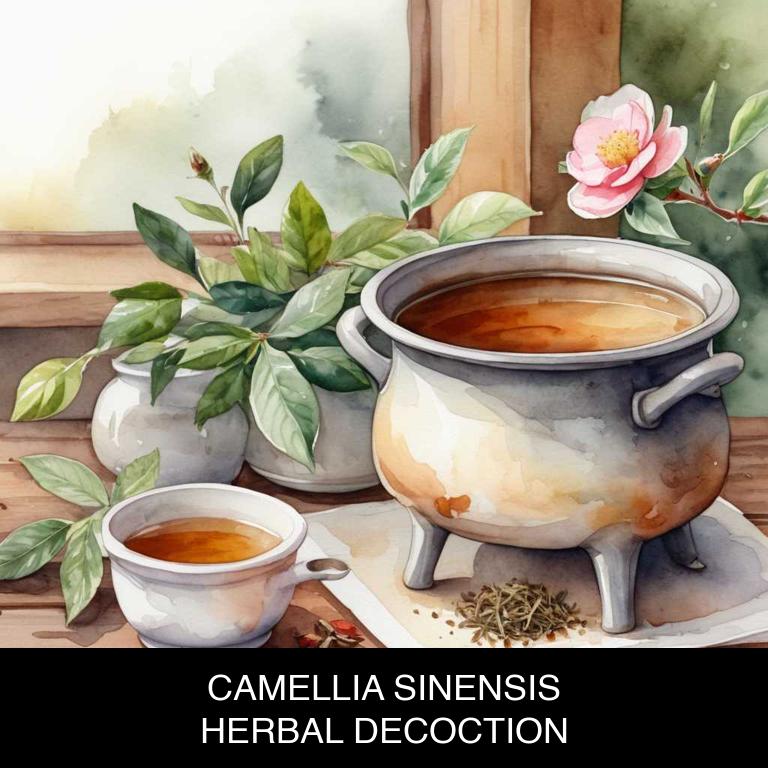
Medicinal Constituents
The list below shows the primary medicinal constituents in Camellia sinensis decoctions that help with peptic ulcers.
- Quercetin: Quercetin, a flavonoid phenolic compound, helps with peptic ulcers by reducing inflammation and oxidative stress in the gastrointestinal tract.
- Catechin: Catechin, a flavan-3-ol phenolic compound, helps with peptic ulcers by inhibiting the production of stomach acid and reducing the growth of Helicobacter pylori bacteria.
- Epigallocatechin gallate: EGCG, a catechin-type polyphenol, helps with peptic ulcers by reducing inflammation, promoting wound healing, and inhibiting the production of stomach acid and pepsin.
Parts Used
The list below shows the primary parts of tea used to make decoctions for peptic ulcers.
- Leaves: High in antioxidants, which help reduce inflammation and protect the stomach lining from damage.
- Buds: Contain flavonoids and phenolic compounds that may help soothe and protect the stomach lining.
- Stems: Rich in saponins and other compounds that may aid in reducing inflammation and promoting healing in the stomach.
Quick Recipe
The following recipe gives a procedure to make a basic tea for peptic ulcers.
- Choose high-quality camellia sinensis leaves in whole or broken form to ensure optimal potency.
- Measure out 1 teaspoon of camellia sinensis leaves for every 8 ounces of water required.
- Steep the leaves in boiling water for 3 to 5 minutes to release the desired compounds.
- Strain the mixture through a fine-mesh sieve or cheesecloth to remove the solids completely.
- Allow the decoction to cool before serving and consume within 24 hours for best results.
6. Mentha x piperita
Peppermint decoctions helps with peptic ulcers because of its natural anti-inflammatory and antacid properties.
The menthol in peppermint relaxes the muscles in the digestive tract, reducing inflammation and discomfort associated with ulcer symptoms. Additionally, peppermint's natural acidity-reducing capabilities help neutralize stomach acid, providing relief from heartburn and nausea commonly experienced by those with peptic ulcers.
By soothing and protecting the mucous membranes lining the stomach and intestines, peppermint decoctions can provide effective management of peptic ulcer symptoms.
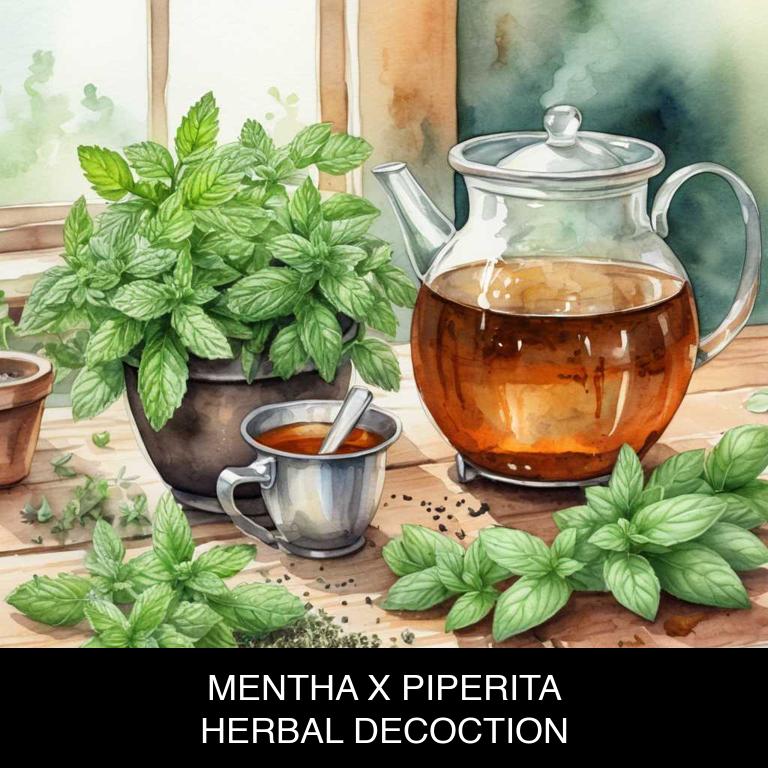
Medicinal Constituents
The list below shows the primary medicinal constituents in Mentha x piperita decoctions that help with peptic ulcers.
- Rosmarinic acid: A polyphenolic compound that acts as an antioxidant and anti-inflammatory agent, helping to reduce oxidative stress and inflammation associated with peptic ulcers.
- Caryophyllene: A sesquiterpene with anti-inflammatory and antioxidant properties, which may help reduce inflammation and promote healing of peptic ulcers.
- Piperitenone: A monoterpene with anti-inflammatory and antimicrobial properties, which may help reduce inflammation, prevent bacterial overgrowth, and promote healing of peptic ulcers.
Parts Used
The list below shows the primary parts of peppermint used to make decoctions for peptic ulcers.
- Leaves: Rich in menthol and menthone, which have anti-inflammatory properties that help soothe and calm digestive issues.
- Stems: Similar to leaves, stems contain menthol and menthone, which can aid in reducing inflammation and discomfort associated with peptic ulcers.
- Roots: The roots contain compounds like limonene and beta-pinene, which have antispasmodic properties that can help alleviate digestive spasms and cramps.
Quick Recipe
The following recipe gives a procedure to make a basic peppermint for peptic ulcers.
- Gather 1-2 teaspoons of dried mentha x piperita leaves and flowers for decoction.
- Combine the gathered herbal material with 1 quart of boiling water in a saucepan.
- Steep the herbal mixture for 5-7 minutes to allow the active ingredients to infuse.
- Strain the decoction through a cheesecloth or fine-mesh sieve into a clean container.
- Allow the decoction to cool and store it in the refrigerator for up to 24 hours.
7. Matricaria chamomilla
Chamomile decoctions helps with peptic ulcers because of its anti-inflammatory properties, which reduce inflammation in the stomach lining, providing relief from painful symptoms.
The soothing compounds in chamomile also help to protect the mucous membranes from further damage, allowing for faster healing and reducing the risk of recurring ulcers.
Additionally, chamomile's antioxidant properties help to neutralize harmful free radicals that can contribute to ulcer formation, promoting overall digestive health and well-being.
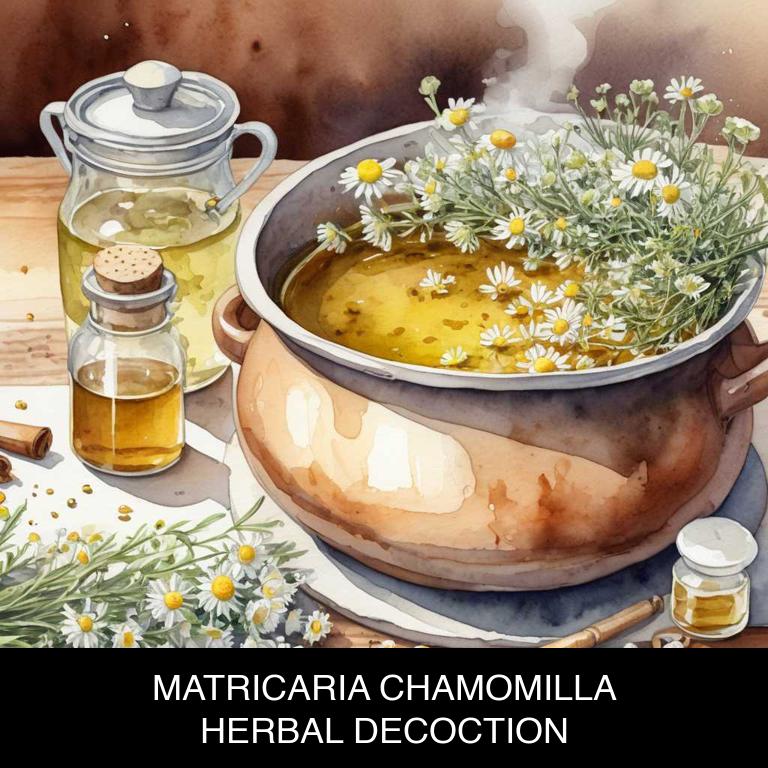
Medicinal Constituents
The list below shows the primary medicinal constituents in Matricaria chamomilla decoctions that help with peptic ulcers.
- Apigenin: Apigenin, a flavonoid, helps with peptic ulcers by reducing inflammation and protecting the stomach lining from acid damage.
- Luteolin: Luteolin, another flavonoid, has anti-inflammatory and antioxidant properties, which help alleviate symptoms of peptic ulcers by reducing inflammation and promoting healing.
- Bisabolol: Bisabolol, a sesquiterpene alcohol, has anti-inflammatory and soothing properties, which help alleviate stomach pain, inflammation, and discomfort associated with peptic ulcers.
Parts Used
The list below shows the primary parts of chamomile used to make decoctions for peptic ulcers.
- Flowers: They are used to make decoctions for peptic ulcers due to their anti-inflammatory and antispasmodic properties that help soothe digestive issues.
- Leaves: They are used to make decoctions for peptic ulcers due to their mild sedative and anti-inflammatory effects that aid in calming digestive discomfort.
- Seeds: They are used to make decoctions for peptic ulcers due to their anti-inflammatory properties that help reduce inflammation in the digestive tract.
Quick Recipe
The following recipe gives a procedure to make a basic chamomile for peptic ulcers.
- Measure out 2 to 4 teaspoons of dried matricaria chamomilla flowers to make a decoction.
- Combine the measured flowers with 2 cups of water in a saucepan over medium heat.
- Bring the mixture to a boil then reduce the heat to low and simmer for 5 to 10 minutes.
- Strain the decoction through a cheesecloth or a fine-mesh sieve into a cup or container.
- Let the decoction cool to room temperature before consuming it as a herbal remedy.
8. Triticum aestivum
Wheat decoctions helps with peptic ulcers because they contain anti-inflammatory compounds that soothe the stomach lining, reducing inflammation and irritation.
The decoction's antimicrobial properties also help eliminate Helicobacter pylori bacteria, a common cause of peptic ulcers. Additionally, wheat decoctions promote mucin production, which forms a protective barrier against acid and enzymes in the stomach, thereby protecting the ulcerated area from further damage.
This natural remedy can provide relief from symptoms such as abdominal pain and nausea, ultimately promoting healing and recovery.
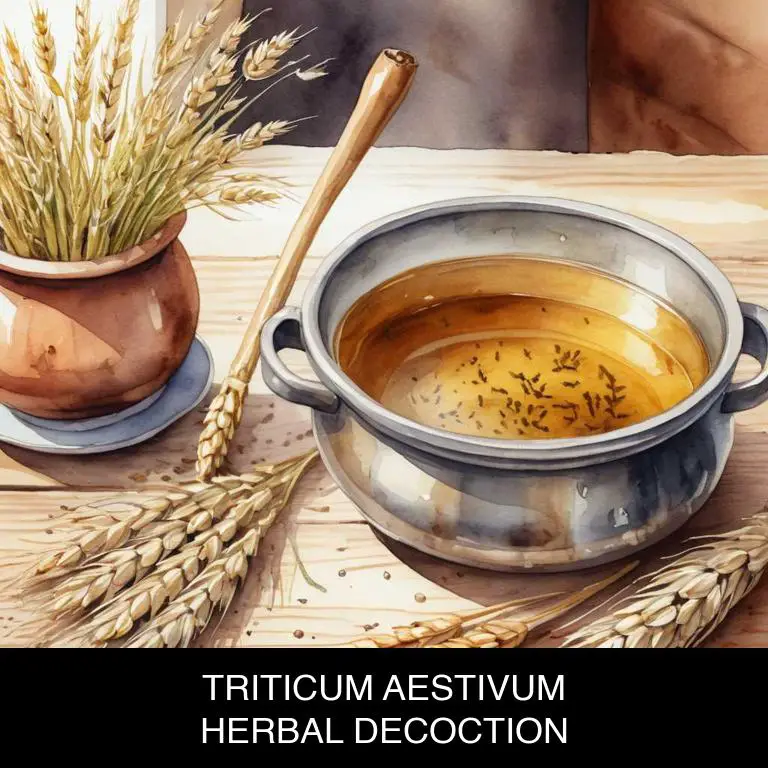
Medicinal Constituents
The list below shows the primary medicinal constituents in Triticum aestivum decoctions that help with peptic ulcers.
- Avenanthramides: These phenolic compounds have anti-inflammatory and antioxidant properties, which help to reduce inflammation and protect the mucous lining of the stomach, thereby aiding in the healing of peptic ulcers.
- Ferulic acid: A phenolic compound that has antioxidant and anti-inflammatory effects, ferulic acid helps to reduce the production of stomach acid, which can contribute to the development of peptic ulcers, and promotes the healing of the ulcerated area.
- Phytic acid: A phenolic compound with antioxidant and anti-inflammatory properties, phytic acid helps to reduce the formation of gastric acid and protect the mucous lining of the stomach, thereby aiding in the prevention and healing of peptic ulcers.
Parts Used
The list below shows the primary parts of wheat used to make decoctions for peptic ulcers.
- Seeds: They contain anti-inflammatory properties that help in soothing the stomach lining and reducing inflammation associated with peptic ulcers.
- Leaves: The avenanthramides present in wheat leaves have been shown to have antioxidant and anti-inflammatory effects, which can aid in healing peptic ulcers.
- Buds: Wheat buds contain compounds that may help protect the stomach lining and reduce inflammation, potentially alleviating symptoms of peptic ulcers.
Quick Recipe
The following recipe gives a procedure to make a basic wheat for peptic ulcers.
- Harvest fresh triticum aestivum root, stems, and leaves in the early morning for maximum potency.
- Chop 2-3 teaspoons of the fresh plant material into small pieces to increase surface area.
- Combine the chopped plant material with 1 cup of boiling water in a heat-resistant glass container.
- Steep the mixture for 5-7 minutes, then strain it using a fine-mesh sieve to remove solids.
- Store the cooled decoction in a dark glass bottle for up to 24 hours before consumption.
9. Taraxacum officinale
Dandelion decoctions helps with peptic ulcers because of its unique combination of flavonoids, terpenes, and alkaloids.
The antioxidant properties of these compounds help to reduce inflammation and protect the mucous membrane lining the stomach and duodenum from damage caused by Helicobacter pylori bacteria and other irritants. Additionally, dandelion's natural bitters stimulate digestive enzymes, improving gut motility and reducing gastric acid secretion, which can exacerbate ulcer symptoms.
By promoting healthy digestion and reducing inflammation, dandelion decoctions can provide relief from peptic ulcer symptoms.

Medicinal Constituents
The list below shows the primary medicinal constituents in Taraxacum officinale decoctions that help with peptic ulcers.
- Triterpenoids: Triterpenoids, specifically ursolic acid and oleanolic acid, in Taraxacum officinale decoctions exhibit anti-inflammatory and antioxidant properties, which help reduce inflammation and promote healing in peptic ulcers.
- Phenolic acids: Phenolic acids, such as caffeic acid and ferulic acid, have been shown to exhibit antimicrobial and anti-inflammatory activities, which can help reduce bacterial overgrowth and inflammation in the stomach, contributing to peptic ulcer healing.
- Flavonoids: Flavonoids, such as quercetin and kaempferol, possess antioxidant and anti-inflammatory properties that can help protect the stomach lining from damage, reduce inflammation, and promote healing in peptic ulcers.
Parts Used
The list below shows the primary parts of dandelion used to make decoctions for peptic ulcers.
- Roots: They contain inulin, which helps to soothe and protect the stomach lining, reducing inflammation and discomfort associated with peptic ulcers.
- Leaves: They are rich in flavonoids and phenolic acids, which have anti-inflammatory properties that can help to reduce pain and inflammation in peptic ulcers.
- Flowers: They contain flavonoids and saponins that have anti-inflammatory and antioxidant effects, which can help to protect the stomach lining and reduce the risk of complications from peptic ulcers.
Quick Recipe
The following recipe gives a procedure to make a basic dandelion for peptic ulcers.
- Harvest 10-20 fresh taraxacum officinale roots in the morning after the dew has dried.
- Clean the roots by gently scrubbing them with a soft brush and rinse with cold water.
- Chop 2-3 grams of the cleaned roots into small pieces and add to 200ml of boiling water.
- Reduce the heat to low and simmer the mixture for 10-15 minutes or until the liquid has reduced.
- Strain the decoction through a cheesecloth or a fine-mesh sieve into a clean container.
10. Urtica dioica
Stinging nettle decoctions helps with peptic ulcers because of its unique combination of bioactive compounds that provide anti-inflammatory, antioxidant, and mucilaginous properties.
The decoction's mucilage content soothes the stomach lining, reducing inflammation and irritation caused by peptic ulceration. Additionally, its flavonoids and phenolic acids have been shown to inhibit the production of gastric acid and pepsin, thereby preventing further erosion of the stomach lining and promoting healing.
This natural remedy provides a gentle yet effective solution for managing peptic ulcers without resorting to harsh medications.
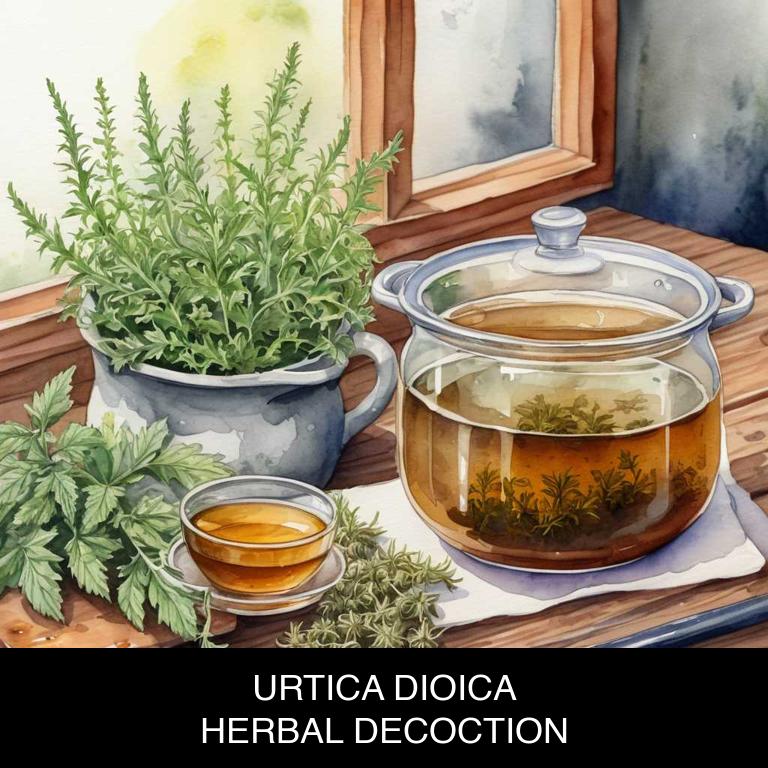
Medicinal Constituents
The list below shows the primary medicinal constituents in Urtica dioica decoctions that help with peptic ulcers.
- Polyphenols: They help with peptic ulcers by reducing inflammation and oxidative stress in the stomach lining, which can contribute to ulcer formation.
- Ursolic acid: It helps with peptic ulcers by inhibiting the production of stomach acid and reducing inflammation, thereby providing protection to the stomach lining.
- Alkylamides: They help with peptic ulcers by modulating the gut-brain axis and reducing inflammation, which can contribute to ulcer formation and healing.
Parts Used
The list below shows the primary parts of stinging nettle used to make decoctions for peptic ulcers.
- Roots: The roots are rich in mucilage, which helps to soothe and protect the stomach lining.
- Leaves: The leaves contain astringent properties, which can help to reduce inflammation and promote healing in the stomach.
- Stems: The stems contain anti-inflammatory compounds, which can help to reduce pain and discomfort associated with peptic ulcers.
Quick Recipe
The following recipe gives a procedure to make a basic stinging nettle for peptic ulcers.
- Harvest 1-2 pounds of fresh leaves and stems of urtica dioica in the early morning.
- Rinse the harvested plant material under cold running water to remove any dirt or debris.
- Chop the fresh urtica dioica into small pieces and add 2 cups of water to a saucepan.
- Bring the chopped plant material to a boil then reduce heat and simmer for 10-15 minutes.
- Strain the decoction through a cheesecloth or a fine-mesh sieve into a clean container.
What is the best combination of herbal decoctions to use for peptic ulcers?
The best combination of herbal decoctions that help with peptic ulcers is a blend of licorice root, slippery elm, and aloe vera.
Licorice root soothes and protects the stomach lining, while slippery elm forms a barrier to prevent acid from irritating the digestive tract. Aloe vera provides anti-inflammatory properties to reduce inflammation and promote healing. Together, these decoctions help to reduce symptoms, promote the healing of peptic ulcers, and support overall digestive health.
This combination can be consumed as a tea or taken as a supplement under medical guidance.
What ailments similar to peptic ulcers are treated with herbal decoctions?
Ailments similar to peptic ulcers that are treated with herbal decoctions are gastritis, esophagitis, and gastroesophageal reflux disease (GERD).
Herbal remedies like Slippery Elm, Marshmallow Root, and Licorice Root help soothe the mucous membranes in the stomach and digestive tract, reducing inflammation and discomfort.
Decoctions of herbs such as Ginger, Turmeric, and Cumin have also been traditionally used to alleviate symptoms of indigestion, nausea, and bloating associated with these conditions.